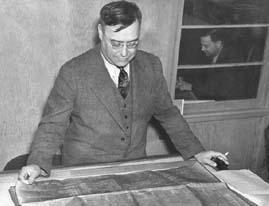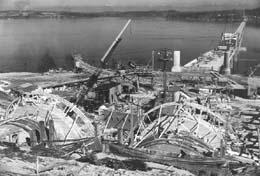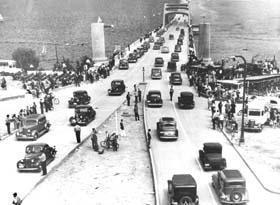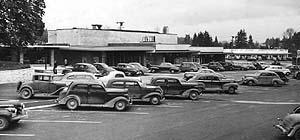By Sharon Boswell
and Lorraine McConaghy
Special to The Times

IN 1939, THE COUNTRYSIDE EAST OF LAKE WASHINGTON WAS FOCUSED on the little market city of Kirkland.
In town, chicken ranchers and dairy farmers could buy seed and feed, get a tooth pulled, and stock up
on groceries. Every hour, the lake ferry's arrival pulsed trucks, cars and foot passengers through town.
But five minutes outside of Kirkland, the Eastside grew sleepy, almost primitive, dotted with worn
farmhouses along muddy lanes. The King County Housing Authority worried about rural poverty on the Eastside
-- ramshackle houses and poor sanitation.
To the south, Bellevue was not really a town at all in 1939. "There was no 'there,' there,"
joked locals, thinking of the handful of stores along Main Street and the endless fields of berries and vegetables.
Bellevue was a sprawling, unincorporated district best known for its Strawberry Festival. Along the lakeshore,
there were a few elegant homes amid the rustic summer cottages of Medina and the Points -- the Gold Coast of
the future.
But from Bothell to Renton, lake to mountains, the Eastside dozed on gentle country time.
As the 1940s began, two events awakened east King County to different futures:
construction of the first bridge to span Lake Washington and dramatic industrialization of the
Houghton lakeshore, in what is now south Kirkland. The revitalized Lake Washington Shipyards would
skyrocket on the wartime homefront, only to sputter and fade. But the bridge would turn the Eastside
toward a suburban future, and pulled the momentum of growth south from Kirkland to Bellevue.

When the Lake Washington bridge opened in 1940, it was the largest
floating structure in the world. Charles Andrew was the chief consulting engineer
on the project. Photo Credit: Seattle Times.
In 1937, the U.S. Coast and Geodetic Survey awarded
the shipyard a contract to build an oceanographic charting vessel. When The Explorer was launched,
the yard already had the contract to build a sister ship, The Pathfinder. And, in 1940, the shipyard
mobilized to construct anti-submarine net tenders and seaplane tenders for the Navy. At the time,
more than 1,000 men worked in this lakefront industry.
Many workers commuted from Seattle by ferry -- it was either that or drive all
the way around the lake.
Since 1923, a wooden bridge spanned the channel between Bellevue and Mercer Island,
connecting islanders to the long drive to Seattle through Renton. But the lake offered Eastsiders
their best way to get to the city, and lake ferry traffic totaled more than 900,000 foot passengers
and 200,000 cars in 1939.
 Framing for the twin tunnel entrances was still visible three months from completion,
at right. Photo Credit: Seattle Times.
Framing for the twin tunnel entrances was still visible three months from completion,
at right. Photo Credit: Seattle Times.
PEOPLE HAD BEEN TALKING ABOUT BRIDGING LAKE WASHINGTON to Seattle for 50 years.
But, in the late 1930s, a visionary effort to link Spokane to saltwater finally took off, powered by
nearly $4 million in Public Works Administration money and a bond issue of $5.5 million, to be
repaid by bridge tolls.
C.B. Blethen, publisher of The Seattle Times, had long opposed bridging the lake.
He was convinced that the proposed pontoon design was not only ugly and extravagantly expensive but
also as "outmoded as a stone hatchet." Indeed, he feared that, "lurching in the grip of a real storm,"
the bridge might break apart and sink. Blethen fought the bridge for a decade and, as he put it, "caused
The Seattle Times to fight it," too.
The Lake Washington Floating Bridge opened to privileged visitors at the end of June 1940.
State highway director Lacey V. Murrow phoned Blethen at his Medina home and invited the publisher out for
a drive over the new bridge. The publisher found the span elegant and convenient, and graciously adapted
his mea culpa from Alice in Wonderland, "There are two reasons for eating crow . . . One is because you have to
and the other is because you should." Blethen had to confess: He had fallen for the bridge.

When the bridge opened July 2, a crowd of 3,000 gathered to enjoy the festivities and stroll or ride across the span. Bellevue boosters had touted the quick trip that would link a Seattle job with a country home, and Kirkland began losing its commuters to the tiny town farther south. Photo Credit: Seattle Times.
HE WASN'T THE ONLY ONE. Local people loved to cruise slowly across from the Seattle side,
ignoring the lane stripings, then make a sweeping U-turn before the toll plaza. And it proved irresistible to
park midspan and take snapshots of Mount Rainier, or to stop in the tunnel approach and lean on the horn,
listening to the echo. The Times sternly reprimanded such frivolities, reminding travelers that an average of
2,800 cars would soon cross the bridge each day.
The Sunset Highway -- today's Interstate 90 -- shot east up and over the mountains,
off to "the land of tomorrow" in Eastern Washington. For a 25-cent toll, a car and driver could cut 14
miles off the trip from Seattle to Spokane. And The Times noted -- almost as an aside -- that the bridge
opened a "large residential area on the east side of Lake Washington to quick and easy commuting."
The bridge encouraged development of the Sunset Highway corridor, and underlay the
Eastside's explosive postwar growth. On Mercer Island, population and property values leapt more than 300
percent between 1940 and 1950. Irate island landowners angrily protested their 1944 assessments,
blaming wartime inflation for prices that approached $100 per lakefront foot.
Bellevue's strawberry fields bristled with "For Sale" signs. The first tenants of
Bellevue Square -- the Bel-Vue Theatre, the Crabapple Restaurant, and Frederick and Nelson -- opened in
1946. It all happened so fast. Bellevue's last strawberry festival was in 1941; Mercer Island's last
deer-hunting season was in 1942.
 By 1947, The Times was praising Bellevue's new Shopping Center which featured the Bel-Vue Theatre.
By 1947, The Times was praising Bellevue's new Shopping Center which featured the Bel-Vue Theatre.
Photo Credit: Seattle Times.
FOR A TIME, THE NORTH LAKE FERRIES CONTINUED to carry passengers and freight between
Madison Park and downtown Kirkland. The Lake Washington Shipyards employed more than 8,000 workers at
the wartime peak, and Kirkland's business community banked on the shipyard's payroll. But the postwar
Eastside didn't choose an industrial future. In 1946, the shipyard closed and, two years later,
Kirkland's Chamber of Commerce called for construction of a second, more northerly, bridge.
It would take 15 years.
In 1950, the last ferry ran to Kirkland, once called the Hub of the Eastside; three years later,
Bellevue incorporated. The bridge had led to the future.
Historians Sharon Boswell and Lorraine McConaghy teach at local universities and do research,
writing and oral history.